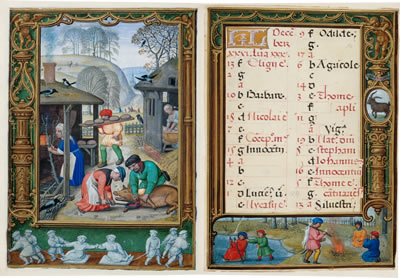
I originally wrote this post as part of the Spectacular Historical Fiction Writers’ December Blog Hop – of course I chose to write about the Tudor Court, which was a wild and wonderful place at Christmas time. But it still applies!
After four weeks of Advent (during which people fasted – no meat, cheese, or eggs – and prayed and prepared themselves), the celebrations began at midnight mass on Christmas Eve and went on for twelve days of feasting that built in intensity until Twelfth Night. Everything centered around these celebrations during this time: all work would stop (other than looking after the animals) until Plough Monday, the first Monday after Twelfth Night, and workers would have a real break (women would even place ceremonial flowers on their spinning wheels so they could not be used).
The Court was an especially magical place at Christmas, decorated with garlands of greenery (holly, ivy, yew, mistletoe, box, and laurel), dried fruits and berries, and of course candles. Every courtier attended so the palace was packed, and even the public got a chance to celebrate with their sovereign: they were often allowed in (not all the way, mind you) to watch the mummeries and share some of the food and drink.
The centerpiece of the feast was a Tudor Christmas Pie, where meats were sealed inside each other like a Russian nesting doll: a pigeon inside a partridge inside a chicken inside a goose inside a turkey inside a pastry “coffin”. (Yes, turkey: Turkey was first introduced into Britain in about 1523 and Henry was one of the first to add it to the Christmas feast, along with the more traditional boar’s head, peacock, swan, partridges, quails, roast beef and prawn pasties). And of course Christmas pudding, minced pye (with thirteen ingredients to represent Christ and his apostles…and a little mutton as a nod to the shepherds), and a drink from the Wassail bowl on Twelfth Night…
Presents were exchanged on New Year’s Day – and when I say exchanged I mean that every courtier gave the King a present, and every courtier that mattered got one back. It was a carefully choreographed ritual, and the giving was a chance to show loyalty and curry favor. You could always default to gold or jewels or plate, but people often tried to give something more personalized than that (women would often embroider shirts for the King…). Elizabeth wins the prize for this one: in 1545, she translated a collection of prayers into Latin, French and Italian) for her father, and for Katherine Parr she translated Marguerite de Navarre’s Mirror of the Sinful Soul for Katherine Parr and embroidered the cover of the volume. (If you want to read more about gifts, check out this post where I went into pretty good detail on the Gift Roll for 1534 – and the difference in Henry’s gifts to Anne that year, when they were married, and 1529, when he was still chasing her).

Celebrations continued after New Years Day, with the entire world turned on its head. I use that term deliberately, because one of the favorite customs involve temporary role reversals: the appointment of a Boy Bishop (a choir or altar boy who would take the place of the Bishop – at least until 1542 when the practice was abolished by Henry VIII), and a Lord of Misrule (who would take the place of the King). Everything culminated on Twelfth Night to celebrate the Feast of the Epiphany, a grand finale which had its own special traditions. Wassailing was a particularly Twelfth Night thing, as was Twelfth Cake which was baked with a pea or bean or coin inside. The lucky person who found it would be king or queen for the night, leading the singing and dancing or whatever amusements were planned (the tradition continues in France with the Galette des Rois)…until midnight when the Christmas season would end and the “real” world would resume…
***
If you like my posts, you’ll love my books! My Seymour Saga trilogy tells the gripping story of the short-lived dynasty that shaped the Tudor Era. Jane the Quene skews romantic, The Path to Somerset is pure Game of Thrones (without the dragons), and The Boy King is a noir coming-of-age. Get them now through Amazon, Barnes & Noble, Kobo, and Apple, or even your local independent bookstore!

(PS Already read them? Did you love them? Then please review them – even just a stars rating! It makes a huge difference in helping new readers find them and would mean the world to me!)
There is definately a great deal to find out about this issue.
I like all of the points you’ve made.
Make merry didn’t always happen in summer when the sun shone! Our ancestors made the most of festive times!
[…] 11th Dec Janet Wertman: Christmas at the Tudor Court […]
[…] 11th Dec Janet Wertman: Christmas at the Tudor Court […]